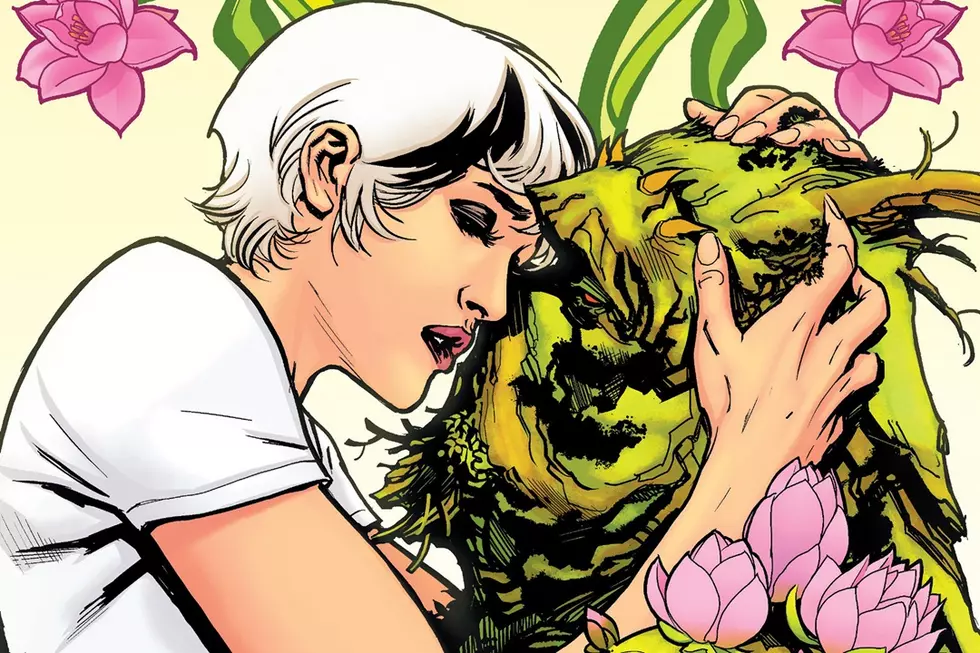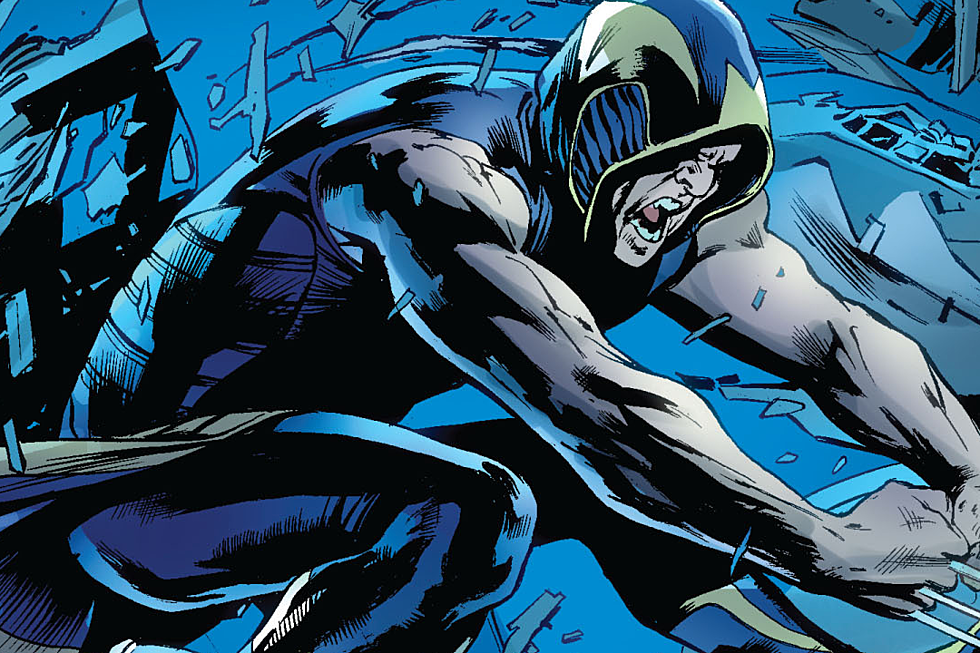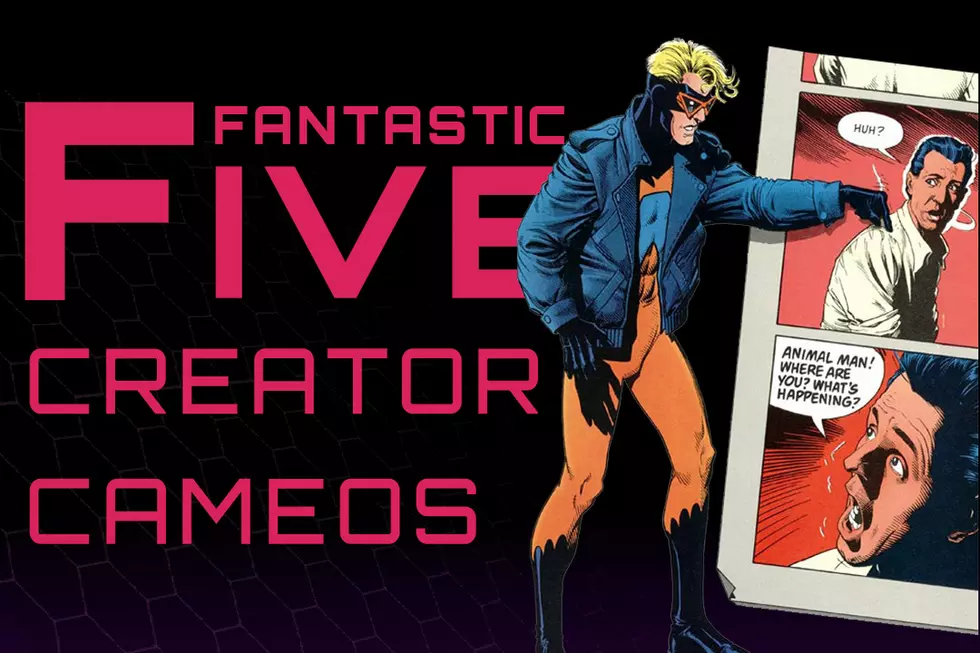
Anatomy of a Classic: ‘Fantastic Four’ #50
 Forty-four years after it was originally published, Stan Lee and Jack Kirby's "Fantastic Four" #50 is justifiably regarded as a classic story and one of the building blocks of the Marvel universe. And until recently, it's also a comic I'd never read.
Forty-four years after it was originally published, Stan Lee and Jack Kirby's "Fantastic Four" #50 is justifiably regarded as a classic story and one of the building blocks of the Marvel universe. And until recently, it's also a comic I'd never read.
As much as I'm a huge Kirby fan, I've always been more interested in the books he did on his own in the '70s -- "OMAC" and "The New Gods" at DC, then his return to Marvel with "Devil Dinosaur," "Captain America" and "The Eternals" -- than his work with Lee building the Marvel Universe. Even so, working in a comic book store for six years and writing about comics every day for the past five and a half, I was pretty sure I'd picked up on the gist of it, because after all, you don't read Marvel comics for two decades without figuring out who Galactus and the Silver Surfer are.
When I finally did sit down and read through them, however, I realized that #50 wasn't just the story of Galactus coming to Earth and getting chased off when Reed Richards waved around the Ultimate Nullifier, it was a major turning point -- not just for the Fantastic Four, or even Marvel, but for comic book storytelling as a whole.For those of you who haven't read a lot of comics from the '60s, I can't stress enough how amazingly different Lee and Kirby's Marvel was from its competition. At DC, the early '60s were the height of the Silver Age and everything that comics readers think of when they hear that term, including an all-powerful Superman whose main concerns generally involved stuff like being made to act like a hobo by the strange rays of a comet. The Marvel books, however, were a radical departure in almost every way except for the fact that they still used staples to hold the pages together.
 It's not just a matter of the fact that Marvel was showing heroes that had problems the average reader could relate to, either -- although Peter Parker's difficulties in making the rent and Ben Grimm's lingering depression and self-doubt over his monstrous body are the most obvious elements, and would mark a transition in comic book storytelling over the next twenty years. It was everything, right down to how the books were presented. At a time when every Batman story was solely credited on the page to Bob Kane and Superman comics lacked any credits, Lee and Kirby's names made their first appearance in "Fantastic Four" #3 and were soon joined by credits for inkers and letterers as well.
It's not just a matter of the fact that Marvel was showing heroes that had problems the average reader could relate to, either -- although Peter Parker's difficulties in making the rent and Ben Grimm's lingering depression and self-doubt over his monstrous body are the most obvious elements, and would mark a transition in comic book storytelling over the next twenty years. It was everything, right down to how the books were presented. At a time when every Batman story was solely credited on the page to Bob Kane and Superman comics lacked any credits, Lee and Kirby's names made their first appearance in "Fantastic Four" #3 and were soon joined by credits for inkers and letterers as well.
Even the letters pages were different. The first time I ever saw a letters page from a Silver Age DC book, I was genuinely surprised at how adversarial they were, full of people demanding to know why Jimmy Olsen was wearing his signal watch on the wrong wrist or offering "corrections," complete with editors correcting the readers right back. In essence, it was the forerunner of the Comics Internet. In the "Fantastic Four Fan Page," however, Lee answered letters with his signature nickname-heavy jocular hucksterism, responding to fans and critics alike with the same affable style, inviting people to share their opinions on what they thought of virtually every aspect of the comics. He even holds a reader vote on the content of the letters pages themselves when someone complains that he spends too much time criticizing his competition, and with the creation of the infamous Marvel No-Prize, he put the onus of explaining his own errors on the reader.
As much as it might look like pandering to the audience, it really did foster a community of readers. For evidence, you don't need to look any further than the letter columns themselves, which feature merry Marvel missives from guys like Don McGregor (future writer of "Killraven," "Power Man" and "Black Panther"), Dave Cockrum (future artist of "Uncanny X-Men"), George R.R. Martin (future author of the "Song of Ice and Fire" novels), Denny O'Neil (writer and editor at both Marvel and DC), and of course, Roy Thomas (who would write 100+ issues of "Conan" and succeed Lee as editor-in-chief of Marvel). That's not to say that DC didn't do their own letters-page recruiting -- Jim Shooter, Cary Bates and Martin Pasko were all creators who came up by writing in -- but whether or not it was genuine, Marvel seemed more willing to both engage the audience on a different level.
The biggest difference, though, isn't a matter of fan relations or crediting creators, or even the way Jack Kirby's art stood in stark contrast to the DC style epitomized by artists like Curt Swan and Kurt Schaffenberger. It has to do with storytelling.

Reading through the first five years of "Fantastic Four" is fascinating, because you can see the transition from Silver Age style stories (Namor attempting to destroy the FF by tricking them into starring in a movie, for instance) to the development of the multi-issue story. The early issues are very much single-issue stories (often divided into "chapters" like the super-hero comics of the time, and like Kirby's work would be well into the '70s), but by "FF" #38, Lee and Kirby were not only carrying over plot elements, but were chaining together issues into fully-defined arcs.
The Fantastic Four fought the Frightful Four for three issues that ended with them losing their powers, then teamed up with Daredevil (who, incidentally, turned his cane into a gun complete with a target-shaped sight, which I thought was hilarious) to fight Dr. Doom for three more issues that end with Ben Grimm getting turned back into the Thing, which in turn leads him to leave the FF and get brainwashed by the Frightful Four, and so on. They had even tied up a lingering plot thread by having Reed and Sue actually get married in direct opposition to the traditional model of the hero who saw romance as detracting from his mission. At a time when their major competitors were still locked into the Silver Age model of three stories per issue (with the occasional daring three-part novel) that neatly returned to the status quo every eight pages, "Fantastic Four" was fostering the evolution of modern comic book storytelling.
And it wasn't a move that was entirely well-received. As much as today's readers (me among them) rail against the over-reliance on decompressed storytelling, the same thing was happening in 1966, with complaints coming from enough readers that Lee took a jab at them on the splash page of "FF" #61:

"Stretched-out" or not, these stories kept getting grander and grander in scale. After the fight with the Frightful Four, they have to fight Dr. Doom without their powers, then one of their own is turned against them, then they face the Inhumans, an entire race of super-powered potential enemies, and it all leads up to Galactus, because that's as high as the stakes could possibly be raised.
When Galactus shows up, things really do seem like they're changing -- in #48, Lee and Kirby even validate him by showing the Skrulls reacting to the Silver Surfer in space:

At this point, the Skrulls had been some of the toughest villains the FF had faced -- they had, in fact killed Sue and Johnny's father -- and in the simple narrative trick of showing them to be afraid of Galactus, the threat was immediately recast as something more far-reaching than anything Earth had seen before.
Added to that was a level of danger that came from the signature Marvel level of humanity Lee and Kirby had given their characters. In the same months that these stories hit newsstands, comics readers could also pick up comics where the plots revolved entirely around the fact that Superman would never act anything less than perfect and encouraged readers to pay their 12 cents and find out just why he was living in a clapboard shack as a hobo.
In "Fantastic Four," however, the characters had no idea what was going on and ended up getting into fistfights with the public just for trying to figure it all out:

(There is nothing in these four panels, by the way, that is not awesome, up to and including Ben's slight frown at being punched in the jaw, the phrase "belt in the Labonzza," and the fact that he totally looks like he's throwing up the Metal Horns.)
The appearance of the Watcher has, much like Galactus himself, become a signifier of a creator using shorthand to show an event is serious, but when he shows up here alongside the Skrulls and a Reed Richards who's sporting a three-day beard because he's spent the last nine issues being smacked around and turning his friend back into a monster and hasn't had time to shave, it reads like they're gearing up for the finale of a fifty-issue mini-series. They had no idea what they were facing, they didn't know if they could defeat it, and by the time the issue ended, things hadn't gotten better, they'd actually gotten worse, and they only continued to get worse in #49.
Which brings us, at long last, to "Fantasitc Four" #50.

The cover and the splash page put the emphasis on the Silver Surfer, which points to a very important element of the story, and one that was truly revolutionary for its time: Throughout the three issues of the Galactus saga, the Fantastic Four don't really do anything.
Reed, Sue and Ben appear on this page doing the same thing they've done since Galactus's arrival: Standing around gawking at what's going on, hiding behind a force field and trying to comprehend what they've been caught up in. The previous issues showed Reed trying to invent his way out of the problem, and Ben wrecking some equipment, but the net effect of it was to delay Galactus's destruction of Earth for about three panels, causing Galactus to summon the Punisher (not to be confused with Frank Castle, who was still a decade away from showing up under that name) so that Kirby could draw a fight scene. The Fantastic Four are utterly insignificant, and they know it.
The only one of the title characters who actually does do anything in the entire story is Johnny, who flies across space and time to retrieve the Ultimate Nullifier, and while that sounds pretty impressive, even that's done not on his own, but with the step-by-step guidance of the watcher:

He's less of a hero than an errand boy, and while it does give him something to do -- and give Kirby some nifty outer-space vistas to draw -- it seems like on a lot of levels, that's all it does, much like the fight with the Punisher.
Ordinarily, the fact that main characters are reduced to bit players in their own title would be a warning sign for a bad story, or at least one in which the writer had painted himself into a corner and had to rely on a last-minute deus ex machina to fix things, and while that's certainly a valid complaint here in a lot of ways -- the Ultimate Nullifier's stated ability to unmake the universe is about as literal a "god from machine" as you're likely to find -- things feel different. It might be just that we can look back on this as a focal point that Lee, Kirby and a host of other writers and artists have built on, but there's an underlying significance here that, again, is completely unlike anything else going on in comics at the time.
The conceit of every Superman story that was on the shelves with Lee and Kirby's "FF" was that there was no evil so great that Superman couldn't stop it. The conceit of every Batman story was that there was no criminal smarter or tougher than Batman and Robin. But the conceit at the heart of this story, taking place in the flagship book of the newly minted Marvel Universe, is that there is something out there the heroes can't beat. There are forces at play that even the smartest man on Earth can't fathom, that all the Thing's strength can't punch out, that the Invisible Girl can't hide from, that can snuff out the Human Torch's youth and energy.

It's the core storytelling difference between the Galactus saga and its contemporaries at DC: That things don't just threaten the heroes for eight pages at a time before being banished. They're always out there somewhere, they've always been there, and -- another extremely key point -- they don't always result from an absolute evil. It's the first nail in the coffin of the Silver Age, and the start of the next forty years of comics having a love-hate relationship with "realism" and the metaphors creators use to deliver it.
 So if three quarters of the book's main characters are completely irrelevant to the outcome, who does defeat Galactus? The Watcher plays a part, of course, but the lion's share of credit goes to the Silver Surfer and, despite her distinct lack of Power Cosmic, Alicia Masters.
So if three quarters of the book's main characters are completely irrelevant to the outcome, who does defeat Galactus? The Watcher plays a part, of course, but the lion's share of credit goes to the Silver Surfer and, despite her distinct lack of Power Cosmic, Alicia Masters.
This is, as the title implies, the Silver Surfer's story. Over these three issues (and the following year of "FF"), he's the one who undergoes a character arc, arriving as the servant who is just as much of an uncaring force of nature as his master and then learning compassion for humanity. And it all hinges on Alicia. In essence, she and the Surfer are the same character. She rejects her creator -- her father, of course, being the villainous Puppet Master -- to stand with the Fantastic Four, and despite being blind, she's the only one who can see the humanity within the monstrous form of the Thing, and love him for the goodness inside. It's down this exact path that she leads the Surfer, to embrace his newfound compassion and reject his creator, regardless of whether his intentions are evil.
With all this talk of "creators," there's another level to the story at play here. Admittedly, trying to apply symbolism to something that may not have intended it can often lead to a strange interpretation (as evidenced by a letter from "FF" #54)...

...it's hard to ignore the obvious when an all-powerful man with a G on his chest comes down from the sky with a "son" who learns unconditional love for humanity.
The Silver Surfer has often been played as a Christ figure, but it's the differences in the imagery surrounding him that I think are most interesting. If that idea is followed through to its logical conclusion, Galactus steps in for the role of God. Having grown up in South Carolina, I was told more than a few times that, as we have all sinned at one time or another, there was no particular reason for God to not cast us all down into the fiery pits of Hell, and on one level, Galactus fits that perfectly. He has no reason to not destroy the Earth, any more than we have to not make a cow into a stack of hamburgers. But the fact that Galactus is explicitly identified as being both beyond good and evil and so far removed from humanity that we're entirely below his notice casts him not as a wrathful God, but as one that just doesn't care one way or the other. And in a lot of ways, that's more terrifying. Just ask H.P. Lovecraft.
It's worth noting here that in his response to another letter, one that referred to Galactus as "run-of-the-mill," Lee calls him "as all-powerful as you can get without being Odin," which I think brings up an interesting contrast. In Norse mythology (as interpreted by Marvel Comics, anyway), Odin is the Allfather. He is the embodiment of creation, whereas Galactus is destruction personified, and while Stan was probably just throwing that in there because he'd written Thor saying something about Odin being all-powerful that day, it makes an interesting study in contrasts that those were the two most powerful beings in the universe at that point.
The Surfer himself, then, comes to Earth not to herald forgiveness, but rather worldwide destruction dealt out for no other reason than that we're at the bottom of the cosmic food chain. Instead of carrying out his creator's will, the Surfer turns against him, and in punishment, he gets what I think is the most interesting inversion. Where Christ sacrificed his Earthly life and ascended to Heaven, the Surfer is condemned to Earth and denied a return to the heavens:

Within a year of this story, the Silver Surfer would be trapped by Dr. Doom and have his powers stolen, and then thrown into a dungeon where he was tortured with photographs of space, a constant reminder of his punishment for saving the Earth. Dr. Doom also flies around on a surfboard during that story, and while that's irrelevant, it is also awesome and warrants a mention.
If the religious metaphor is carried to its logical conclusion, then, we're left with a messiah for whom Earth is a prison full of madmen out to pervert his power, a God that can only exist by destroying others, and a humanity that desperately needs to prevent him from ever coming back. Pretty heavy stuff, although it's probably not what Lee and Kirby intended.
Regardless, once the Surfer betrays him, Galactus's defeat is a foregone conclusion. When the Surfer sides with humanity, Galactus tells him "for all who live, I have cherished you most of all," and at that moment, he has lost. This is his one moment of weakness, and it's a very human one, and it recasts the battle in an entirely new set of terms. The official end may only come when Reed waves the Ultimate Nullifier at him and threatens to blow him up -- for all its highfalutin' layers of metaphor, this is still a Lee/Kirby Marvel comic, after all, and Reed needed something to do -- but at that point, it's irrelevant. In coming to Earth, he's lost the one thing in the story that he does seem to care about, and nothing he can gain from devouring the planet will replace it.

Thus, Galactus is defeated, which is what I knew all along was going to happen in "Fantastic Four" #50.
Here's what I didn't know, and what absolutely blew my mind: This all happens by page ten.
Say what you want about the merits of decompressed storytelling, but that's an awful lot to cram into ten pages, especially given that it was the climax of a string of stories that had been getting bigger and bigger for the previous year. The ultimate, all-powerful opponent who is still the gold standard for grand cosmic adversaries 44 years later, and they deal with him with half an issue left.
The remaining space is used to move things right along in the typical soap-operatic style of the Marvel books. Johnny Storm, who ten pages earlier passed out when his mind was unable to comprehend a journey through space and time that revealed the utter insignificance of the Human Race, goes to college, where a guy refers to him as "Sportin' Life."

And in what is quite possibly the craziest thing about this entire comic, we're introduced to the next villain to menace the FF. Keep in mind, the Galactus story had been the cap to a series of arcs in which the team had battled virtually their entire roster of super-villains and the Inhumans in rapid succession without a break, then faced a cosmic being whose only purpose was to destroy on a planetary scale.
And to follow that up, Lee and Kirby bring you... this guy.

That's it. Just a dude.
Admittedly, the follow-up issue in which he appears, "This Man, This Monster," is another issue that's justifiably considered a classic, but when this guy makes his appearance as the next step from Galactus, the reaction was less "he must be tough!" and more "wait, are you serious?"
But again, I think that plays into what makes this story work as well as it does: For all the cosmic terror, for all the insignificance of man, for all the messiahs on surfboards, things move on. Again, in a medium that largely saw stories where the status quo was restored at the end of every story like clockwork, Lee and Kirby kept things moving. New threats came up to show that it's not always the grandiose space operas that can get you, sometimes it's just people, and regardless of whatever else Johnny Storm had going on in his life, it was time for him to go to college. It's a forward momentum that we can all relate to, because time marches on for all of us, and even the big, grand endings for the important chapters in our lives don't last for more than a moment before the next one starts.
More From ComicsAlliance









